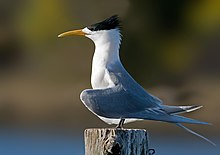Lari (bird)
| Lari | |
|---|---|

| |
| Atlantic yellow-legged gull | |
| Scientific classification | |
| Domain: | Eukaryota |
| Kingdom: | Animalia |
| Phylum: | Chordata |
| Class: | Aves |
| Order: | Charadriiformes |
| Suborder: | Lari Sharpe, 1891 |
| Families | |
| |

The suborder Lari is the part of the order
are now placed into the Lari too, following recent research. [1] Sometimes, the buttonquails are also placed here, but the molecular data and fossil record rather suggests they are a quite basal offshoot along with the snipe-like and aberrant waders.[2]The larids are generally larger species that take fish from the sea. Several gulls and skuas will also take food items from beaches, or rob smaller species, and some have become adapted to inland environments.
The suborder Lari includes five to six families:[3][4]
- Family Dromadidae– crab-plover
- Family Glareolidae – coursers, pratincoles (17 species)
- Family Laridae – gulls, terns, skimmers (103 species)
- Family Stercorariidae– skuas (7 species)
- Family Alcidae– auks (25 species)
and sometimes:
- Family Turnicidae– buttonquails (18 species)
| |||||||||||||||||||||||||||||||||
| A family level phylogeny of the suborder Lari based a study by Heiner Kuhl and collaborators published in 2020. Pamela Rasmussen and David Donsker on behalf of the International Ornithologists' Union.[4]
|
References
- .
- ^ Paton et al., 2003; Thomas et al., 2004; Paton & Baker, 2006
- ISBN 978-0-9568611-0-8.
- ^ Rasmussen, Pamela, eds. (July 2021). "IOC World Bird List Version 11.2". International Ornithologists' Union. Retrieved 19 December 2021.
- PMID 32781465.
Sources
- Paton, Tara A.; Baker, Allan J. (2006). "Sequences from 14 mitochondrial genes provide a well-supported phylogeny of the Charadriiform birds congruent with the nuclear RAG-1 tree". Molecular Phylogenetics and Evolution. 39 (3): 657–667. PMID 16531074.
- Paton, T. A.; Baker, A. J.; Groth, J. G.; Barrowclough, G. F. (2003). "RAG-1 sequences resolve phylogenetic relationships within charadriiform birds". Molecular Phylogenetics and Evolution. 29 (2): 268–278. PMID 13678682.
- Thomas, Gavin H.; Wills, Matthew A.; Székely, Tamás (2004). "A supertree approach to shorebird phylogeny". PMID 15329156.
